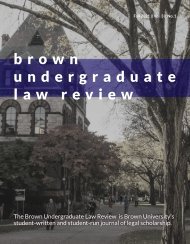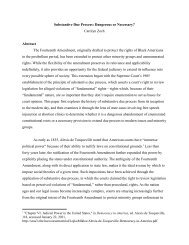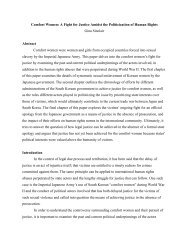Brown Undergraduate Law Review — Vol. 2 No. 2 (Spring 2021)
We are proud to present the Spring 2021 issue of the Brown Undergraduate Law Review. We hope that the works contained herein offer insight and inspiration to all who read them.
We are proud to present the Spring 2021 issue of the Brown Undergraduate Law Review. We hope that the works contained herein offer insight and inspiration to all who read them.
Create successful ePaper yourself
Turn your PDF publications into a flip-book with our unique Google optimized e-Paper software.
Standardizing Autonomy: Medical Communication, Liability, and the Doctrine of Informed Consent<br />
malpractice action filed against Dr. Bullis by Jandre disclosure? maintaining that while physicians may rely on<br />
included claims of negligent misdiagnosis as well as professional customs to adjudicate their treatment, care,<br />
negligence with respect to informed consent. In their and diagnosis, informed consent is governed by the<br />
request for review, the Physicians Insurance Company of reasonable patient?s desire for information ?regardless of<br />
Wisconsin (PIC) contended that the inconsistency of the what disclosures may be customary in the medical<br />
jury?s original verdicts rendered the informed consent profession.? 46 In Jandre, these two standards appear at<br />
claim invalid. Given that Dr. Bullis? diagnosis of Bell?s odds: Jandre?s (retrospective) wish to hear the full range of<br />
palsy, ? though incorrect, ? was found not to be negligent possible diagnoses, tests and treatments related to his<br />
by the professional standard applied to misdiagnosis symptoms undermined Dr. Bullis? diagnosis of Bell?s<br />
claims, PIC argued that Dr. Bullis had no enforceable duty palsy.<br />
to inform Jandre about the carotid ultrasound, a diagnostic The Wisconsin Supreme Court?s refusal to delimit risk<br />
test for an unrelated diagnosis of ischemic stroke. 43 materiality at once obstructed and weakened physicians?<br />
Physician-defendant Dr. Richards made a similar argument diagnostic prerogative. Despite insisting that its application<br />
in Martin, claiming that if his diagnosis and care was not of the reasonable patient standard would not impose strict<br />
negligent, then ?as a matter of law? he could not be found liability upon physicians, the Jandre court?s unusually<br />
negligent for ?failing to discuss a diagnosis which he did broad definition of materiality suggested otherwise. On the<br />
not make.? 44 However, as noted in Justice Roggensack?s one hand, the court took pains to emphasize the limits of<br />
dissenting opinion, while Fort Atkinson Hospital?s physicians?disclosure duties, reassuring doctors that they<br />
inability to treat intracranial bleeding (should it develop as had ?no duty to provide information to patients about<br />
a result of Ms. Martin?s concussion) could be construed as tests? that a reasonable patient would not consider<br />
a risk inherent in Dr. Richards? proposed treatment, in material. 47 At the same time, physicians could deem few<br />
Jandre?s case ischemic stroke represented a separate procedures definitively immaterial according to Jandre?s<br />
diagnosis altogether? and a discarded one at that. 45 The standard, whereby, ?[f]rom the perspective of the patient,<br />
Jandre court justified this widening of treatments and the materiality of risk has nothing to do with whether that<br />
diagnoses mandating disclosure under Wis. Stat. §448.30 risk comes from a potential condition that is related to the<br />
by distinguishing the discrete legal standards applicable to final diagnosis, as in Martin ? or from a potential<br />
Jandre?s respective claims of negligent diagnosis and condition that the physician has eliminated, though not<br />
43. Ibid., 813 N.W.2d 649. (?PIC?s basic argument is that it is anomalous to impose liability for breach of the duty to inform the patient when, as in<br />
the present case, the physician was not negligent in her care and diagnosis of the patient.?)<br />
44. Ibid., 813 N.W.2d 650.<br />
45. Ibid., 813 N.W.2d 680. (?In Martin, the recommended treatment for Ms. Martin?s head trauma was to remain at Fort Atkinson Hospital for<br />
careful observation. However, the risk of that treatment, i.e., a significant delay in surgery if it became necessary due to an intercranial bleed, was not<br />
explained.?)<br />
46. Ibid., 813 N.W.2d 649, 650. (?Under Wisconsin law, negligence in failing to abide by the professional standard of care and negligence in failing<br />
to obtain informed consent are two separate and distinct forms of malpractice, with two different standards of care. A failure to diagnose is one form<br />
of medical malpractice. A failure to obtain informed consent is another discrete form of malpractice, requiring a consideration of additional and<br />
different factors. There is nothing anomalous or inconsistent in holding that a reasonable patient may want information about alternative diagnostic<br />
techniques when the physician was not negligent in using one of multiple alternative, non-negligent techniques. To hold otherwise would<br />
substantially undercut the reasonable patient standard.?)<br />
47. Ibid., 813 N.W.2d 662. (?Physicians have no duty to provide information to patients about tests that would not be material to a reasonable patient.<br />
The holding in the present case does not give patients leave to request all conceivable tests. <strong>No</strong>r do physicians have a duty to perform tests that are<br />
not medically reasonable.?)<br />
<strong>Brown</strong> <strong>Undergraduate</strong> <strong>Law</strong> <strong>Review</strong><br />
38










